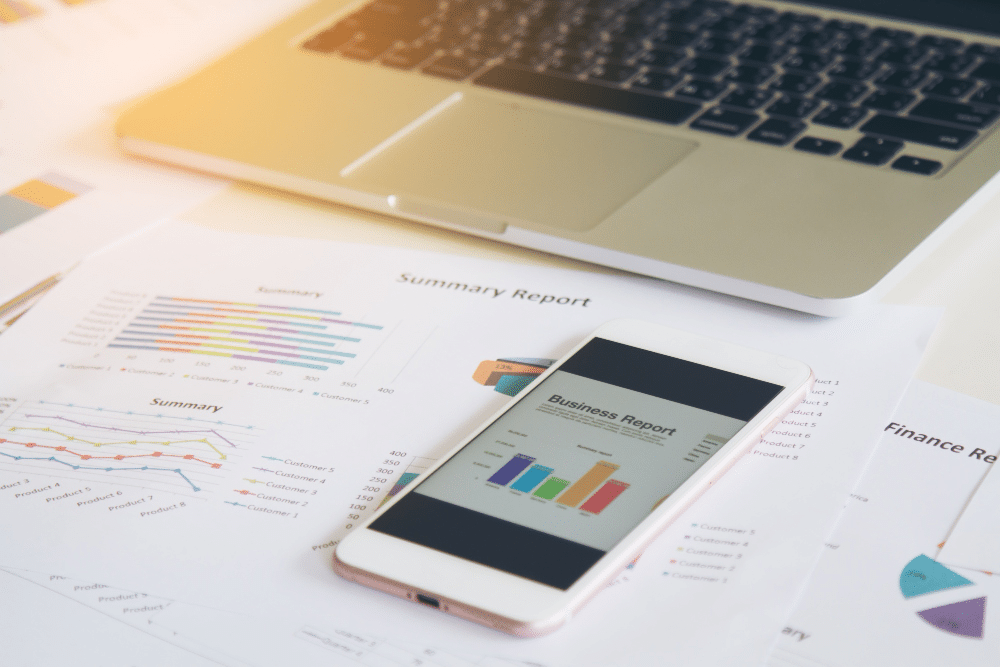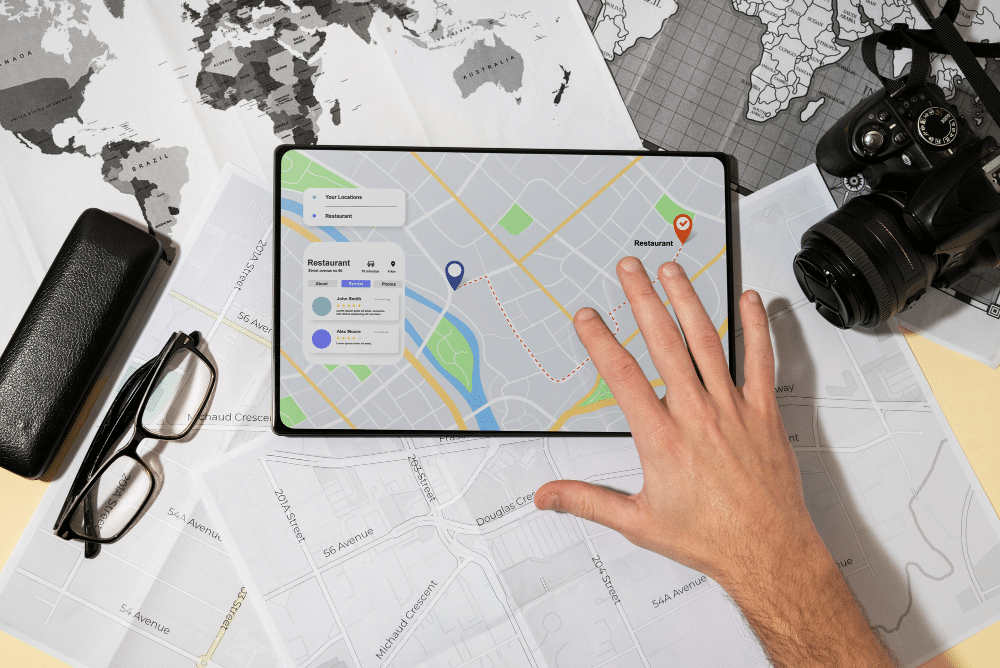
In the ever-evolving world of digital marketing, Local Search Engine Optimisation (SEO) has become a vital tool for businesses aiming to capture the attention of local customers. The efficacy of Local SEO strategies is deeply intertwined with the quality of reporting.
This article delves into 8 practical tips to enhance your Local SEO reporting, ensuring your business remains ahead in the competitive local market.
1) Utilise Local Keywords Effectively

Local keywords are the linchpin of a successful Local SEO strategy. They are specifically tailored to attract the attention of potential customers in a defined geographic area.
Let’s dig a little deeper.
Understanding and Identifying Local Keywords
Local keywords are search phrases that include location-specific terms. These terms are used by potential customers seeking services or products in their area.
For example, a search query like “best coffee shop in Aukland” is a local keyword targeting a specific Aukland audience.
Tools like Google Keyword Planner and local customer surveys can provide insights into the popular search terms related to your business in a specific location.
Integrating Local Keywords into Your Content
Once you have a list of relevant local keywords, the next step is to integrate them naturally into your website content, blog posts, meta descriptions, and titles.
These keywords must fit organically within the content to enhance readability and avoid being penalised by search engines for keyword stuffing.
Local Keyword Variations And Monitoring Keyword Performance
It’s also beneficial to consider variations and long-tail keywords. For instance, alongside “best coffee shop in Aukland”, consider including “top Aukland café” or ” speciality coffee in Aukland City Centre”. This approach captures a broader range of search queries.
Finally, effective use of local keywords requires continuous monitoring and adaptation. SEO reporting should include tracking the performance of these keywords in terms of search rankings, click-through rates, and conversions. This data helps in refining the keyword strategy.
2) Focus on Google My Business Optimisation

Optimising your Google My Business (GMB) listing is a crucial part of Local SEO. It can enhance your visibility in local search results. Google My Business is a free tool. This tool helps businesses maintain their online presence across Google. This includes search results and Google Maps.
Properly optimising your GMB profile can increase engagement, better local rankings, and, ultimately, more customers.
Claiming and Verifying Your Listing
The first step in Google business profile optimisation is to claim and verify your business listing. This process authenticates your business and gives you control over the information displayed in Google searches and Maps in location pages.
Verification is typically done via a postal code or phone call from Google.
Providing Complete and Accurate Information
Once verified, ensure that your GMB profile is complete and accurate. This includes your address, business name, phone number, website, and business hours in the Google search knowledge panel. These are very important local SEO tips.
Consistency in this information across the web helps improve Google search local results. It ensures customers receive correct details about your business.
Utilising Categories and Attributes
Google My Business lets you select categories and attributes that best describe your business.
Choosing the most accurate categories helps Google understand what your business offers and ensures it appears in relevant local searches.
Attributes can include details like wheelchair accessibility, free Wi-Fi, or outdoor seating, providing potential customers with valuable information at a glance.
Adding High-Quality Photos and Videos
Visual elements can significantly enhance your GMB listing. Adding high-quality photos and videos of your services, products, premises, and staff gives potential customers a better understanding of what to expect.
In a local SEO audit, it was revealed that businesses with photos on their listings generally receive more clicks to their websites and requests for directions.
Encouraging and Responding to Reviews
Online reviews play an important part in Local SEO. It also helps in customer decision-making. Request satisfied customers to leave reviews on your GMB profile. Importantly, respond to these reviews, whether they are positive or negative.
Engaging with reviews shows that you value customer feedback and are committed to improving service.
Posting Regular Updates
Google My Business allows posting updates, offers, events, and other content directly on your listing. All this appears on the search engine results pages also known as online directories.
Regular updates keep your profile active and engaging, positively impacting your local search ranking and attracting more attention from potential customers.
Monitoring GMB Insights
Finally, use Google My Business Insights to monitor how customers interact with your listing. Insights provide valuable data on how customers found your listing, their actions, and other interaction metrics.
3) Incorporate Location-Based Metrics

Incorporating location-based metrics into your Local SEO reporting is crucial for understanding how well your business performs in specific geographical areas. These metrics provide valuable insights into local consumer behaviour, preferences, and the effectiveness of your local SEO strategies.
By closely monitoring these indicators, businesses can make data-driven decisions to enhance their local presence and appeal to their target audience more effectively.
Understanding Location-Based Metrics
Location-based metrics refer to data that is specific to a particular geographical location.
These can include:
Local search rankings
Traffic from specific areas
Engagement metrics like clicks and calls from local listings
In-store visits, if applicable.
Tracking Local Search Rankings
One of the most essential location-based metrics is your business’s ranking in local search results for relevant keywords. High rankings in local searches are indicative of successful local SEO efforts.
Tracking these rankings helps understand how visible your business is to the local audience and which areas need improvement.
Analysing Geographic-Specific Traffic
Website traffic from different locations can be monitored using tools like Google Analytics. By segmenting traffic data by location, you can gauge which areas drive the most visits and which might need more targeted SEO efforts.
Monitoring Engagement with Local Listings
Engagement metrics, such as the number of calls, direction requests, or clicks on your local listings, are vital indicators of how effectively your business captures local interest. These metrics can be tracked through Google My Business Insights and similar tools.
Using In-Store Visits and Foot Traffic Data
For businesses with physical locations, measuring in-store visits and foot traffic can provide direct insights into the impact of local SEO. This can be tracked through various technologies like Wi-Fi tracking or by analysing location-based offers and promotions.
Local Conversion Metrics
Ultimately, the goal of local SEO is not just to increase visibility but also to drive conversions. Tracking location-based conversion metrics like in-store purchases, appointment bookings, or online sales from specific locations helps evaluate the ROI of local SEO efforts.
Customising Reporting for Different Locations
Businesses operating in multiple locations should customise their SEO reporting for each area. This includes local keyword performance, competitor analysis in each locale, and user engagement trends specific to each area.
Regularly Updating and Refining Strategies
The digital landscape is dynamic, and what works today may not be as effective tomorrow. Regularly updating and refining your local SEO strategies based on current location-based metrics is essential.
This includes adjusting your local keyword strategy, content, and even your local listings per evolving trends and data.
4) Leverage Customer Reviews and Rating

Customer reviews and ratings are pivotal in Local SEO, significantly influencing a business’s online reputation and search engine rankings. These feedback elements provide valuable insights for potential customers and serve as a key metric for search engines. This helps in determining the relevance and quality of a business.
Effectively leveraging customer reviews and ratings can improve visibility and trustworthiness in local search results.
The Role Customer Reviews Play in Local SEO
Reviews are a form of social proof, offering prospective customers a glimpse into the experiences of others. A business with substantial positive reviews will likely attract more customers.
Moreover, search engines like Google consider reviews as a factor in ranking local businesses. Regularly receiving fresh, positive reviews can boost your local search visibility.
Encouraging Customers to Leave Reviews
Encourage customers to leave reviews. For that, you have to send follow-up emails after they purchase a product or service, asking for feedback or providing easy access to review platforms through QR codes or direct links.
However, it’s essential to follow the guidelines of each review platform regarding soliciting reviews.
Responding to Reviews
Replying both positive and negative reviews is essential. It shows that your business values customer feedback and is committed to improving the customer experience.
In particular, personalised responses to negative reviews can mitigate any adverse effects by demonstrating your willingness to address concerns.
Managing Negative Reviews
Negative reviews should be handled professionally and constructively. Addressing the issues raised and offering to resolve them can turn a negative experience into a positive one.
This approach potentially retains a dissatisfied customer and shows others that your business is responsive and customer-focused.
Show Reviews on Your Social Media and Website

Display reviews on your social media channels and website. This will help enhance your business’s credibility. Featuring a mix of reviews, including some that have been responded to, can provide a balanced and transparent view of your business.
Monitoring and Analysing Review Trends
Regularly monitoring and analysing trends in your reviews can provide insights into customer satisfaction, service quality, and areas needing improvement. This analysis should be a part of your Local SEO reporting, as it can guide strategic decisions and improvements.
Leveraging Third-Party Review Sites
In addition to Google My Business, consider leveraging other relevant third-party review sites. These might include industry-specific platforms or local business directories. Having a presence on multiple review sites can enhance your online credibility and visibility.
Using Reviews to Improve Service and SEO
Reviews can offer direct feedback on what your business is doing well and what could be improved. Use this feedback to improve your services or products. Additionally, reviews often contain keywords and phrases relevant to your business, which can contribute positively to your SEO efforts.
5) Utilise Local Backlink Data

Local backlinks, links from other local websites to your own, play a crucial role in Local SEO. They act as endorsements of your business from other local entities, contributing significantly to your local search engine rankings and overall online visibility.
Effectively utilising local backlink data involves acquiring these links and analysing and leveraging them to strengthen your Local SEO strategy.
Understanding the Importance of Local Backlinks
Backlinks are important for search engines as they help in ranking. These are also important for local searches.
When a local business, blog, or news site links to your website, it tells all the search engines that your business is a relevant and integral part of the local community. This can help boost your visibility in local search results, especially for users searching for services or products in your area.
Identifying Potential Local Backlink Opportunities
The first step in leveraging local backlinks is to identify potential sources for these links. This could include local news websites, blogs, business directories, and community websites.
Collaborating with local events, sponsorships, or community initiatives can also be a great way to earn local backlinks.
Creating Quality, Localised Content
To attract local backlinks, it’s essential to create high-quality, localised content that is relevant and useful to your community. This could include blog posts about local events, guides to local attractions, or resources specific to your local area.
Quality content is shared and linked to by local websites more often.
Building Relationships with Local Entities
Building relationships with local businesses and organisations can lead to natural backlink opportunities. Networking, attending local events, or even reaching out directly to propose collaborations can be effective strategies for building these local connections.
Monitoring Your Local Backlink Profile

Regularly monitoring your backlink profile is crucial. This involves tracking who is linking to you, the quality of these links, and the context in which they are placed. Tools like Ahrefs or Moz can help you track and evaluate your backlinks’ impact.
Analysing Backlink Quality
Not all backlinks are created equal. The quality of the linking site, its relevance to your business, and the way the link is integrated into content all play a part in determining the value of a backlink.
Focus on acquiring high-quality backlinks from reputable local sources.
Responding to Negative or Spammy Links
Occasionally, you might find your site linked to a low-quality or irrelevant source. These links can negatively impact your SEO. Most SEO tools offer options to disavow these links, telling search engines to ignore them.
Leveraging Backlink Data for Strategic Insights
Finally, analysing your backlink data can provide strategic insights. This might include understanding which types of content are most effective in attracting backlinks or identifying new local partnership opportunities.
6) Monitor Local Competitor Activities

Monitoring the activities of local competitors is an essential aspect of a robust Local SEO strategy. By closely monitoring your competitors, you can gain valuable insights into their tactics.
You can also identify emerging trends in the local market, and discover opportunities to enhance your SEO efforts. This competitive analysis enables businesses to stay ahead in the local digital landscape.
Understanding the Competitive Landscape
Begin by identifying your main local competitors. These may include businesses offering similar products or services in your area. Understanding who you compete with is the first step in effectively monitoring their activities.
Analysing Competitors’ SEO Strategies
Examine the SEO strategies of your competitors. This includes analysing their use of local keywords and the structure and content of their websites. Plus you also need to analyse their Google My Business profiles, and their backlink profiles.
Tools like SEMrush or Ahrefs can provide insights into their SEO performance and tactics.
Monitoring Competitors’ Online Reviews and Ratings
Online reviews and ratings are valuable for your business and offer insights into what customers appreciate or dislike about your competitors.
Regularly check these reviews to understand their strengths and weaknesses, customer service quality, and product or service offerings.
Keeping Track of Local Listings and Citations

Local listings and citations (mentions of a business’s name, address, and phone number) play a crucial role in Local SEO. Monitor where and how your competitors are listed in local directories and other relevant sites. This can reveal opportunities for your own business to get listed or improve existing listings.
Observing Social Media Activities
Social media can inform your competitors’ marketing strategies and customer engagement. Pay attention to their posts, customer interactions, promotional campaigns, and any local events or sponsorships they are involved in.
Analysing Content and Marketing Strategies
Take a close look at the type of content your competitors are producing. Are they focusing on blog posts, videos, local news updates, or guides?
Understanding their content strategy can provide ideas and inspiration for your content, helping you fill gaps and differentiate your offerings.
Identifying Gaps and Opportunities
Through your analysis, identify areas where your competitors may be falling short or where there are gaps in the market. These could present opportunities for your business to capitalise on, whether offering a service others don’t or targeting a niche market segment.
Adapting and Refining Your Strategies
Use the insights from monitoring your competitors to adapt and refine your local SEO strategies. This might involve tweaking your keyword strategy, improving your Google My Business profile, enhancing your content marketing, or exploring new local backlink opportunities.
7) Emphasise Mobile Performance and Local Searches

Mobile performance is a critical aspect of Local SEO in today’s digitally driven world. With the increasing prevalence of smartphones, a huge portion of local searches are done on mobile devices.
Therefore, optimising your online presence for mobile users is essential for capturing this growing audience and enhancing your local search rankings.
Understanding the Impact of Mobile on Local Searches
Mobile searches often have local intent, meaning users are looking for products, services, or information in their immediate vicinity. This makes mobile optimisation not just a matter of convenience but a crucial factor in connecting with local customers.
Ensuring Mobile-Friendly Website Design
Your website needs to be designed with smartphone users in mind. This means it should have a responsive design that adjusts seamlessly to different screen sizes, ensuring easy navigation and readability on smartphones and tablets.
Google’s Mobile-Friendly Test can be used to check how your site is performing on smartphones.
Improving Page Load Speeds on Mobile
Page load speed is critical for mobile users, who often seek quick answers, especially when on the go. Use tools like Google’s PageSpeed Insights to analyse and improve your website’s loading times on mobile devices.
Techniques to enhance speed include optimising images, minimising code, and leveraging browser caching.
Localising Mobile Content
Ensure that all the content on your mobile site is localised. This means incorporating local keywords, providing location-specific information, and tailoring content to reflect local events, news, or cultural nuances.
Localised content resonates more with your target audience. It also helps to improve your visibility in local search results.
Utilising Click-to-Call and Maps Integration

Make it simpler for mobile users to get in touch with you or find your location. Features like click-to-call buttons and map integration are essential for a mobile-friendly local business website. These features enhance the user experience and facilitate immediate action from potential customers.
Monitoring Mobile Search Rankings and User Behaviour
Regularly monitor your search rankings for mobile and track user behaviour on your mobile site. Tools like Google Analytics provide insights into how mobile users interact with your site. This includes the pages they visit, the duration of their stay, and their actions (like calling or requesting directions).
Emphasising Local SEO in Mobile Marketing
Incorporate Local SEO strategies into your mobile marketing efforts. This includes optimising for “near me” searches, localising your PPC campaigns, and ensuring your local listings are mobile-friendly and up-to-date.
Staying Updated with Mobile SEO Trends
The mobile digital landscape is constantly changing. So you have to stay in touch with the latest trends and updates in mobile SEO. This ensures your strategies remain effective and responsive to new developments, like changes in search engine algorithms or emerging mobile technologies.
8) Regularly Update and Refine Reports

Regularly updating and refining SEO reports is crucial for maintaining and enhancing the effectiveness of your Local SEO strategy. The digital landscape is pretty dynamic. It is constantly evolving, particularly in local contexts.
By staying on top of your reporting, you can make informed decisions, adapt to changes, and continuously improve your approach to meet the needs of your local audience.
The Importance of Ongoing Reporting
Local SEO is not a set-and-forget strategy. Market conditions, consumer behaviours, and search engine algorithms change frequently.
Regular reporting helps you stay informed about these changes and understand how they impact your local search performance.
Setting a Regular Reporting Schedule
Establish a consistent schedule for updating your SEO reports. This could be weekly, bi-weekly, or monthly, depending on the size of your business and the dynamics of your local market.
A regular schedule ensures that you consistently monitor your performance and are ready to respond to changes swiftly.
Tracking Key Performance Indicators (KPIs)
Spot and track the Key Performance Indicators (KPIs) most relevant to your Local SEO goals. These might include local search rankings, website traffic from local searches, click-through rates from local listings, conversion rates, and engagement metrics on local content.
Utilising Advanced Analytics Tools
Leverage advanced analytics tools to gather comprehensive data for your reports. Tools like Google Analytics, Google My Business Insights, and other SEO platforms provide valuable data on your Local SEO performance.
Analysing Competitor Performance
Include an analysis of your competitors in your regular reports. This can provide insights into their strategies, help you identify emerging trends in the local market, and uncover opportunities for your SEO efforts.
Reviewing and Updating Local SEO Strategies

Use the insights from your reports to review and update your Local SEO strategies. This could involve refining your local keyword strategy, enhancing your content for local relevance, or improving your Google My Business listing.
Reporting on Local SEO ROI
Measure and report on your Local SEO activities’ return on investment (ROI). This involves tracking increases in traffic or rankings and how these improvements translate into tangible business outcomes like sales, leads, and customer engagement.
Adapting to Algorithm Updates and Industry Changes
Stay informed about updates to search engine algorithms and changes in the Local SEO industry. Incorporate new guidelines or best practices into your strategy and reflect these changes in your reporting.
Encouraging Team Involvement and Feedback
Involve your team in the reporting process. Encourage feedback and insights from different departments, such as sales, marketing, and customer service. They can give valuable perspectives on the effectiveness of your Local SEO strategy.
Conclusion

Enhancing Local SEO reporting is not just about gathering data. It’s about extracting actionable insights to drive better business decisions.
By implementing these eight tips, businesses can significantly improve their Local SEO efforts, ensuring a robust online presence in their target markets.
